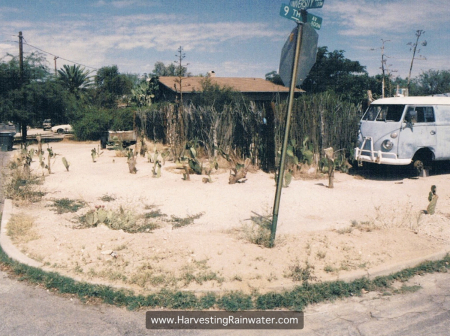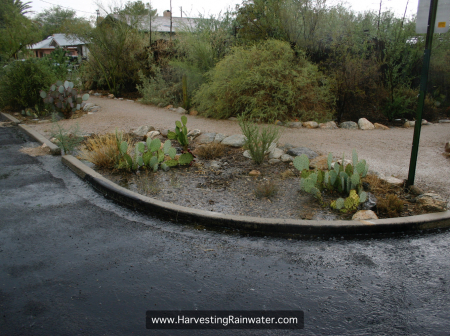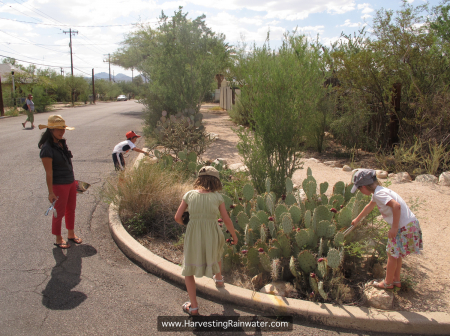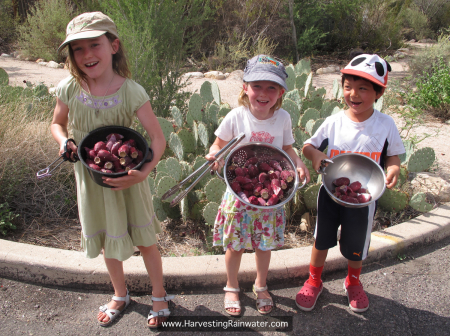Multi-Use Rain-Garden Plant Lists: Invitations to Deeper and More-Connected Relationships
by Brad Lancaster © 2015
www.HarvestingRainwater.com
A story of early motivation
I grew up in the suburbs of Tucson, surrounded by lush desert vegetation. I would climb it, hide in it, and play around it. But I rarely knew any of the plants’ names, and I did not have much of a sense of what their roles (or mine) were in our shared community. It was a pleasant, but fairly shallow relationship, as the knowing of the other, the understanding of the other, was just at the surface level.
It didn’t help that my family had moved here from elsewhere. We were all greenhorns with no shared history or understanding of this place and its life.
But my play began to instill a wonder, a love, and a desire to know and share more. What did the early people of this place eat? What could I eat? Where did they get the things they needed? What could I provide? What would the wildlife eat? How come there were horned lizards, hummingbirds, big trees, water, butterflies, archaeological ruins, and/or dragonflies in some places, but not in others?
These answers and so many more came to light as I took the time and interest to delve deeper, to investigate, and to get to know these patterns and lives. I began to simply take note of where different plants lived—what microclimate (soil type, sun exposure, proximity to a watercourse, etc.) they seemed to prefer. Then I learned their names—through plant books, identification signs at botanical gardens, the local herbarium, or an introduction by a knowledgeable friend or guide on a plant walk.
It’s like getting to know a neighbor seen on a regular neighborhood walk. You learn their patterns, what route they like to walk. A familiarity grows with more interactions, and then you introduce yourself, ask their name, conversation continues, and the relationship grows.
And often you hear a story or learn of a detail that really hooks you. Wait, you were a major food source of the prehistoric people of this area, and you are still eaten today? Can I eat you? Could I try? Oh wow, you are delicious! Oh my, and so many other birds and animals like to eat you. No wonder I see them and their tracks all around you. No wonder I see your seed in their scat (as it soon will be in mine). Interactions, investigations, conversations, and learning continue.
Such was the case with the native velvet mesquite tree, as the conversation and relationship kept evolving… You mean to tell me that you freely fertilize the soil with tiny nitrogen-fixing organisms that live on your roots? That’s amazing, you could help fertilize my garden and shade it from the hot afternoon sun if I planted one of your offspring on the west side of my vegetable plot or orchard. You also attract over 60 native pollinators, while non-native mesquites planted in Arizona attract only about a dozen?! Go co-evolution! Oh man, those pollinators will also help further boost my garden’s production. And what’s up with how I often find the best-tasting mesquite pods are on trees whose pods looked stripped, or shredded? Birds that like sweet pods do that—cool, I’ll let them lead me to my tastiest harvests! No way—migrating neotropical songbirds can increase their body weight by 10–20% in just two to four days by chowing on the insects that are in a single blooming native mesquite tree?! You are an epic provider, especially when you’re growing bigger along a watercourse or within a roadside swale. Oh, that gives me an idea—I’ll create some water-harvesting earthworks beside you to similarly harvest the water pouring off my roof and walkway. That’ll put an end to the flooding against the house, and an end to my having to water the landscape via hose or irrigation line. And those rain-garden basins will also catch and hold your leaf drop—for free and fertile mulch!
A tool and an invitation
Such experiences have been wonderful for me, and I want to make them easier for you and others. Great tools in this endeavor are multi-use rain-garden plant lists. I developed mine from the experiences described above and more.
These multi-use rain-garden plants lists are invitations to collaborate with and enhance living systems in our shared designed/built environments.
They list many human, livestock, and wildlife uses for each featured plant. Each use is a unique invitation into a deeper connection and opportunity for greater potential.
These lists promote multi-functional plantings of rainwater, stormwater, and vegetation which, when done well, will not require supplemental irrigation after the plants get established (the establishment period can take 1–3 years). Thus the water-use and microclimate info in the lists can help us create net-positive water landscapes, meaning the landscapes and their plantings can reinvest more water back into the ecological system than they take out. The lists can help us select and grow local food plants irrigated solely with free on-site local water, rather than with costly water imported from great distances and/or pumped from great depths.
These lists have been created for different bioregions by experts that live, work, play, plant, explore, and experiment with water-harvesting landscapes within those bioregions. And we’d love more. Check out the lists accumulated thus far here. Let us know if you have such lists you’d like to share from your bioregion and climate. Look to the template for what info we recommend you include. Help us evolve these lists/tools. Generate lists, or bring to light great lists others have made for your place. That’s what we are trying to encourage with our Multi-Use Rain-Garden Plant Lists page. It is meant as a platform to share, to give credit to those doing the hard and thoughtful work in generating these amazing resources, and to lift the quality and potential of landscapes being designed today.
Share the lists. We’d love to see plant nurseries, designers, and landscapers post them, group and place plants by their rain-garden zone(s) within water-harvesting earthworks, and list/learn/share the uses of the various plants so more people will get the info, put it into practice, and grow more resilient, deeply beautiful, and productive landscapes.
See the new, full-color, revised editions of Brad’s award-winning books
– available a deep discount, direct from Brad:

Volume 1





